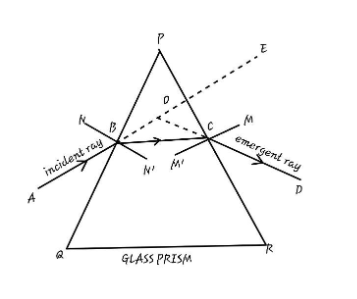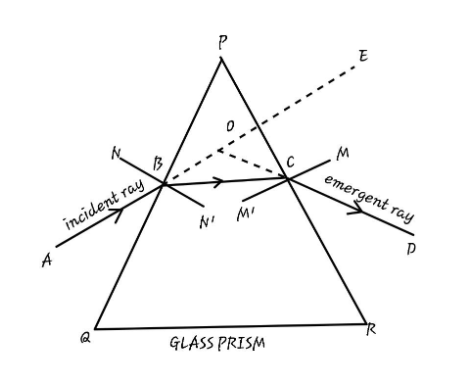
In the diagram given below ∠EOD is known as

(A) Angle of reflection
(B) Angle of emergence
(C) Angle of deviation
(D) Angle of prism
Answer
218.7k+ views
Hint Angle of reflection : - The angle between the reflected ray and the normal is known as the angle of reflection.
Angle of emergence: - The angle of emergence is the angle of the light coming out of a medium (for an example in case of a glass slab with its parallel sides).
Angle of deviation: - Angle between the incident ray and the emergent ray is called the angle of deviation.
Angle of prism: - The angle between the two sides of the reflecting faces of prism is called angle of prism.
Complete step by step answer As shown in the figure EOD is the angle between the incident incident ray and the emergent ray and is calculating the amount of deviation caused by the prism in the incident ray (AB) . Therefore, it is known as angle of deviation.

Thus option C is correct.
Note Dispersion by a prism: - The phenomenon of splitting of light into its component colours is known as dispersion.
The different component colours that appear in sequence are:
violet, indigo, blue, green, yellow, orange
and red (given by the acronym VIBGYOR).
Angle of emergence: - The angle of emergence is the angle of the light coming out of a medium (for an example in case of a glass slab with its parallel sides).
Angle of deviation: - Angle between the incident ray and the emergent ray is called the angle of deviation.
Angle of prism: - The angle between the two sides of the reflecting faces of prism is called angle of prism.
Complete step by step answer As shown in the figure EOD is the angle between the incident incident ray and the emergent ray and is calculating the amount of deviation caused by the prism in the incident ray (AB) . Therefore, it is known as angle of deviation.

Thus option C is correct.
Note Dispersion by a prism: - The phenomenon of splitting of light into its component colours is known as dispersion.
The different component colours that appear in sequence are:
violet, indigo, blue, green, yellow, orange
and red (given by the acronym VIBGYOR).
Recently Updated Pages
Young’s Double Slit Experiment Derivation Explained

Wheatstone Bridge Explained: Working, Formula & Uses

Chemical Properties of Hydrogen - Important Concepts for JEE Exam Preparation

JEE General Topics in Chemistry Important Concepts and Tips

JEE Atomic Structure and Chemical Bonding important Concepts and Tips

JEE Amino Acids and Peptides Important Concepts and Tips for Exam Preparation

Trending doubts
JEE Main 2026: Application Form Open, Exam Dates, Syllabus, Eligibility & Question Papers

Derivation of Equation of Trajectory Explained for Students

Hybridisation in Chemistry – Concept, Types & Applications

Understanding the Angle of Deviation in a Prism

Understanding Collisions: Types and Examples for Students

Understanding Atomic Structure for Beginners

Other Pages
JEE Advanced Marks vs Ranks 2025: Understanding Category-wise Qualifying Marks and Previous Year Cut-offs

How to Convert a Galvanometer into an Ammeter or Voltmeter

Understanding Centrifugal Force in Physics

Ideal and Non-Ideal Solutions Explained for Class 12 Chemistry

Degree of Dissociation: Meaning, Formula, Calculation & Uses

Understanding Electromagnetic Waves and Their Importance




